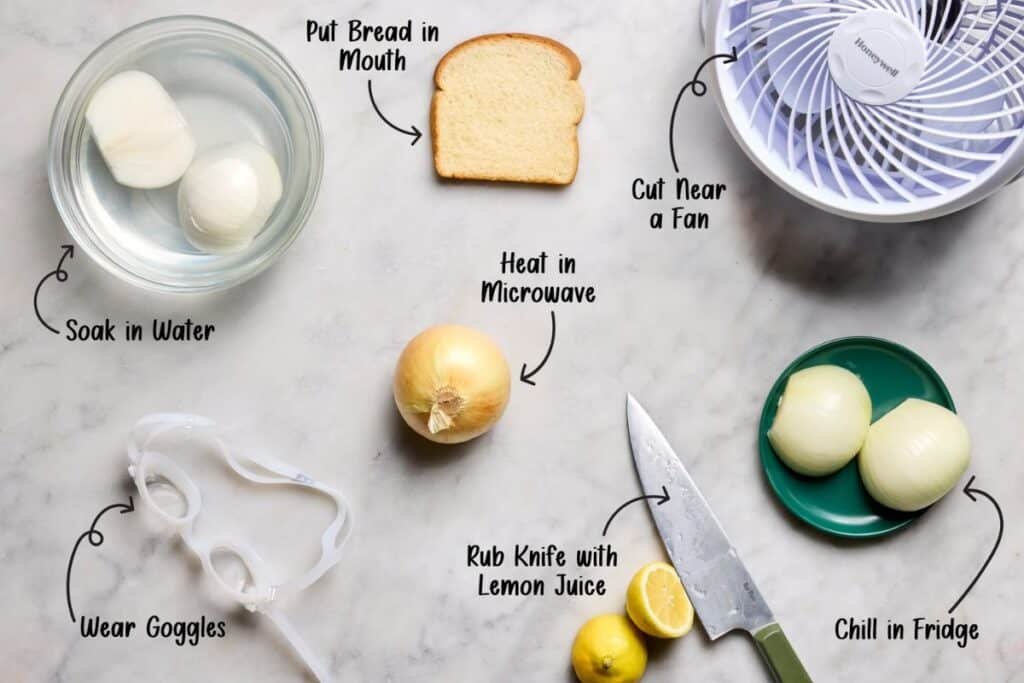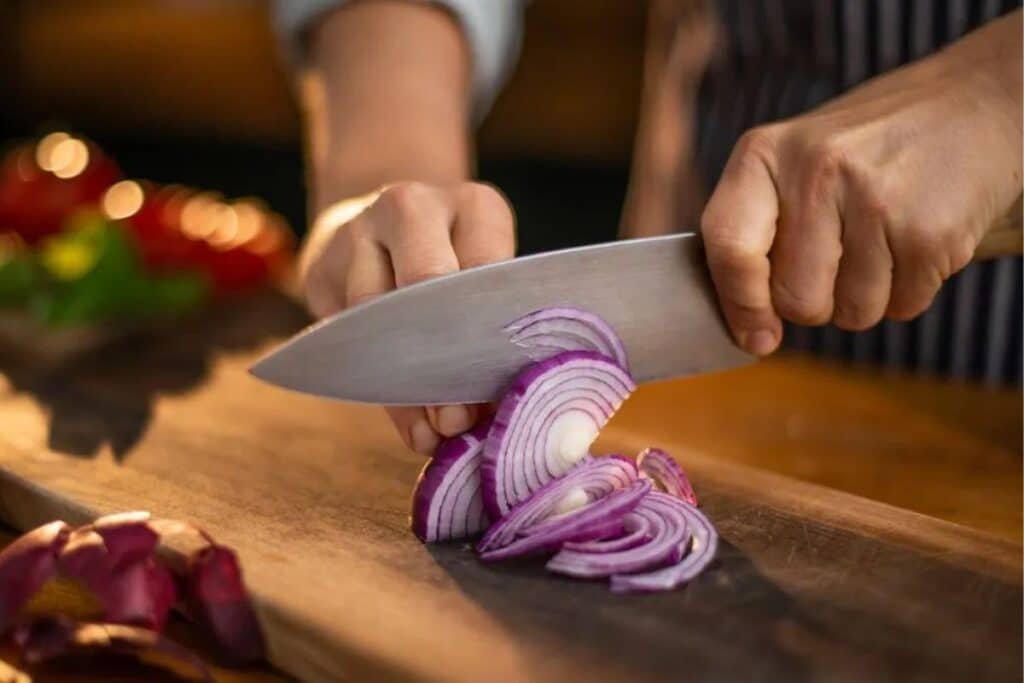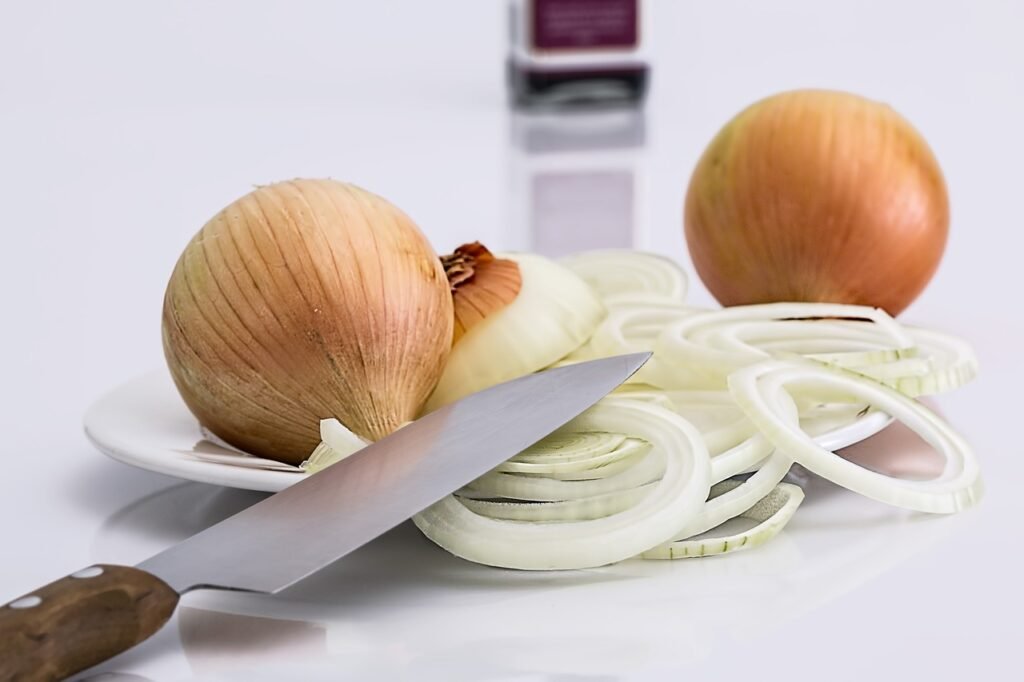Knowing how to cut an onion the right way can save time and effort in the kitchen. If you love crispy onion rings, we’ll show you how to cut an onion into rings with ease. Tired of watery eyes? Don’t worry—we have tricks on how to cut an onion without crying. And for those who need perfectly even pieces, we’ll also cover how to cut an onion into slices or how to cut an onion into rings effortlessly. Get ready to chop onions like a chef!
Beginner’s Guide: How to Cut an Onion into slices Perfectly
Learning to cut an onion well is an important cooking skill. It can make your dishes taste much better. Whether you are new to cooking or want to improve your skills, this guide will help you. You will gain the knowledge and confidence to handle any recipe that uses onions. To cut onions safely and easily, you need a sharp knife and a strong cutting board. We will look at basic techniques like dicing onions for caramelized onions and some more advanced methods. Let’s discover how to cut an onion perfectly.
“This article contains affiliate links. I might get commissions from those links if you click through the link and finalize a purchase. Please read Disclosure section for more information.”
Understanding Onions: Varieties and Uses

Onions are a common ingredient used in kitchens all over the world. They belong to the onion family and come in many flavors, colors, and sizes. Each type of onion adds its own taste and texture to a dish. This makes it very important to pick the right onion for your recipe.
White onions have a strong, sharp flavor. They are great for making savory sauces and soups. On the other hand, Vidalia onions have a mild sweetness. They are often eaten raw in salads. Knowing the differences between these types of onions can really change how well your dish turns out.
Types of Onions and Their Flavors
- Yellow Onions: Yellow onions are very popular in kitchens. They have a strong taste when raw but become softer when cooked. They are great for caramelizing, using in french onion soup, or making tasty onion rings.
- White Onions: White onions are sharper than yellow onions. They add a strong flavor to salsas, guacamole, and cooked foods. Their crisp bite is perfect for salads, too.
- Red Onions: Red onions are mild and a bit sweet. They have a bright color and are often eaten raw. They add color and taste to salads, sandwiches, and homemade salsa.
Selecting the Right Onion for Your Recipe
While some recipes need certain types of onions, knowing basic tips can help when you need to switch them out. For dishes that want a milder onion taste, like salad dressings or smooth sauces, white or sweet onions are the best way to go.
Yellow onions are good for many different dishes. You can use them in soups and stews, or even caramelize them for toppings on burgers. They also work well for making onion rings if you slice them thick.
If a recipe needs a lot of chopped onion, using a large Spanish onion can be timesaving. You can cut it in half and keep the other half for another time.
Preparing How to Cut an Onion Without Crying
Before you begin chopping, it’s important to gather the right tools and prepare your onion well. This can really help with safety and make your work easier. A bit of setup can lead to a better experience when you cut onions.
- Use a strong cutting board that won’t move while you chop.
- A sharp knife is very important. It helps you make clean cuts and reduces onion tears.
- A dull knife takes more effort and crushes the onion, which releases the irritating compounds that make you cry.
Essential Tools and Equipment For How to Cut an Onion into Slices
- Cutting Board: A sturdy and non-slip cutting board is key for cutting onions safely and well. Choose a wooden or plastic board. Glass or ceramic can make your knife dull.
- Sharp Chef’s Knife: Buy a high-quality chef’s knife and keep it sharp. A sharp knife cuts better and uses less force. This helps to protect the onion’s cells and stops too many irritants from coming out.
- Optional: Plastic Wrap: If chopping onions bothers your eyes, think about covering your cutting board with plastic wrap. This can catch some onion fumes and reduce the irritation.
Proper Onion Storage Techniques
Proper storage is very important for keeping your onions fresh and tasty. Whole onions should be kept in a cool, dry place with good air circulation. Keep them out of direct sunlight.
Once you cut an onion, put it in an airtight container or wrap it tightly with plastic wrap. This helps stop it from drying out or taking on other smells in the refrigerator.
To reduce odor from the onion, you can put it in the crisper drawer of the refrigerator. This drawer helps keep the right humidity. When you store a cut onion, make sure the cut side is facing down. This will help it stay fresh longer.
Read more- How to Cut Watermelon: Beginner’s Guide
The Beginner’s Guide How to Cut an Onion into Slices

Now that you are ready, it is time to learn how to cut an onion. This simple guide will help you slice it evenly and make it easier to reduce tears. Make sure to keep your fingers safe and away from the knife while you cut.
If you follow these easy steps, you can handle any onion recipe. Whether you are making a big stew or a light sauce, you will be ready. So, take your cutting board, sharpen your knife, and let’s start chopping.
Step 1: Trim the Ends
Place your onion on the cutting board. Use a sharp knife to cut off the stem end. Remove about half an inch from that end. Next, turn the onion around. Cut off the root end, also removing about half an inch.
Removing both ends gives you a stable base for cutting. It also makes peeling the onion skin much easier. Be careful not to cut too deep into the root end. If you do, the onion could fall apart.
Keep a bit of the root end intact. This will help hold the onion layers together while you slice. Now that you have trimmed the ends, you are ready for the next step.
Step 2: How to Cut an Onion into Slices: Cut in Half and Peel
Place the onion on one of its flat sides. This gives you stability while cutting. Carefully cut the onion in half lengthwise. Start from the stem end and cut through to the root end.
Now, peel off the onion skin. It should come off easily, especially if you’ve trimmed the ends right. If some skin is still on, remove it gently with your fingers or the tip of your knife.
Once you have peeled the onion, throw away the skin. Put the onion halves cut side down on your cutting board. You are now ready to slice or dice!
Step 3: How to Cut an Onion into Slices
Hold one half of the onion tightly with your non-dominant hand. Curl your fingers inward to stay safe. Place your knife straight up and down on the cutting board. Start making thin slices from the end that is not the root.
If you want to make thin slices, get your cuts close together. For thicker slices, like those used in onion rings, leave more space between your cuts. It’s important to keep the spacing even for better cooking.
When you get to the center of the onion, it can help to turn the onion half a little to stay comfortable while cutting. Always keep your fingers away from the blade. Work slowly and carefully.
Step 4: Dicing vs. Slicing Techniques
For diced onion, first, cut vertical lines along the onion half while keeping the root end in place. Next, turn the onion 90 degrees. Make horizontal cuts across the vertical cuts to create small, even pieces.
For sliced onion, keep cutting horizontal slices along the onion half. The thickness of these slices is up to your recipe. Thin slices are best for salads or quick cooking. Thicker slices are better for caramelizing or roasting.
If you learn to dice and slice well, you will improve your cooking skills. This will help you feel more confident with different recipes. Remember, the more you practice, the better you will get!
Advanced Onion Cutting Techniques

Once you know how to dice and slice, you can improve your onion skills with some advanced techniques. At first, these methods might seem hard, but with practice, you can make onion cuts that look like they come from a restaurant.
Cutting onions into julienne strips is a great way to make your dishes look fancy. This technique gives you thin and evenly cooked pieces. Making perfect onion rings needs some skill, but it is worth it. Just be patient and feel free to try new things!
How to Julienne an Onion
Julienne is a French cooking term. It means to cut vegetables into thin, matchstick-like strips. It might seem hard, but once you practice, cutting an onion this way is easy.
First, take one half of the onion. Cut off a small piece along its length to make it flat and stable. Next, slice it thinly from the top down, stopping just before you reach the root end. If you want to make a fine dice, stack a few slices together and cut them into thin strips again.
This cutting method makes your dishes look nice and adds a subtle onion flavor. You can use it for stir-fries, soups, and salads. Learning the julienne cut will impress your family and friends and improve your knife skills, too!
How to Cut an Onion into Rings
Onion rings are a favorite snack or side dish. It is best to use large, sweet onions. Instead of cutting the onion in half, keep the whole onion to make those large rings.
Start by cutting off the stem end, but keep the root end. This helps to keep the onion in one piece while you slice it. Next, take off the onion skin carefully.
Using a sharp chef’s knife, make thin, even cuts across the onion. Start from the stem end and move toward the root end. If you want thinner and crispier onion rings, use thinner slices. That’s how to cut an onion into rings!
Tips How to Cut an Onion Without Crying
Cutting onions often makes us cry and feel a sting in our eyes. This happens because onions release sulfur compounds when we cut them. However, there are some easy tricks you can use to lessen the tears and discomfort. Here’re how to cut an onion without crying!
Though you can’t stop onion tears completely, following a few of these tips can help a lot. By taking some simple steps, you can cut onions without crying.
Chilling Onions Before Cutting
One of the easiest ways to reduce onion tears is to chill the onion before cutting. Put your onion in the refrigerator for 30 minutes to an hour before you cut it.
The cold helps slow down the reaction that causes the irritant, making it less strong. A chilled onion won’t stop all tears, but it can help a lot.
Another good tip is to use a sharp knife. Fewer cuts mean less harm to the onion cells. This means that fewer irritants are released. Think about sharpening your knife before you cut that onion!
Using a Sharp Knife to Reduce Irritation
A sharp knife is important for cutting onions well and avoiding tears. When you use a dull knife, it crushes the onion’s cells and releases a compound that can irritate your eyes. In contrast, a sharp knife makes clean cuts, causing less damage.
When you cut with a sharp knife, use the right technique. Instead of pushing down hard, try to slice by gently moving the blade across the onion.
You can also use the side of the blade to help guide you, which will help you make smoother and more controlled cuts. This will further reduce cell damage. Remember, buying a good quality knife and keeping it sharp helps improve your cooking and makes you feel better!
Conclusion
Mastering how to cut onions is an important skill for any cook. Choosing the right onion and knowing the right techniques can improve the taste and look of your meals. Always remember to trim the ends, peel the skin, and make clean cuts. You can also practice dicing smoothly. Try advanced methods like making onion rings and julienning for extra style. By using these simple steps, you can easily handle any recipe that includes how to cut an onion without crying. Enjoy your cooking!
Frequently Asked Questions
How do I choose the best type of onion for my dish?
Yellow onions are great for many dishes. They are perfect for making caramelized onions or a tasty french onion soup. White onions bring a strong flavor to homemade salsa and cooked meals. Red onions are mild and add color. They work well in salads and salad dressings. Check out different onion recipes to find the ones you like best!
Can I store cut onions, and how?
You can keep onion halves or cut onions in the fridge for about 10 days. Make sure to wrap them well in plastic wrap. You can also put them in an airtight container. Place the onion cut side down. This will help keep the flavor and stop any unwanted smells.
What are the health benefits of onions?
Onions can bring on some tears, but they are actually good for your health. They have few calories and are full of antioxidants. These can help keep your immune system healthy. If you need specific nutrition information, check trusted sources.










Pingback: Easy Watermelon Cutting Tips: How to Cut a Watermelon